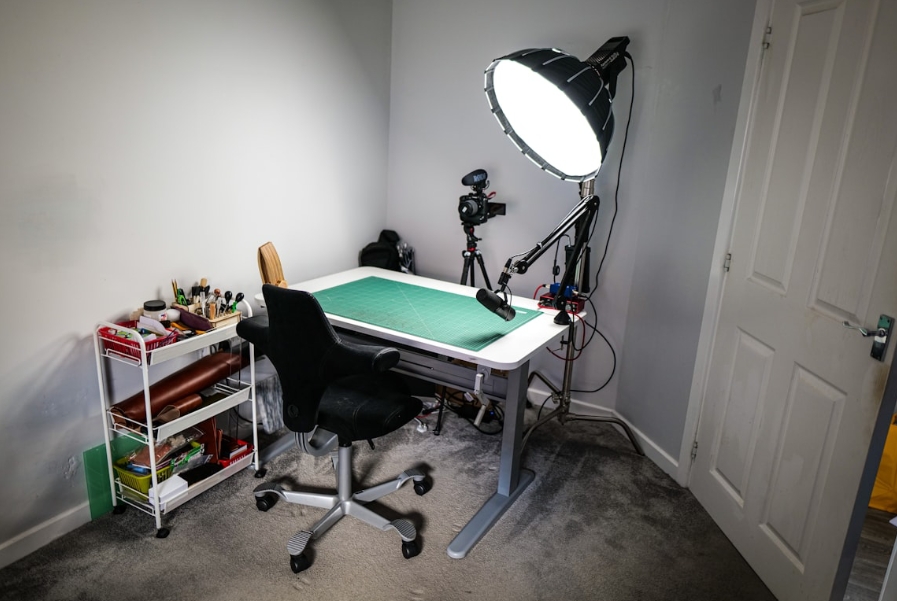A good setup plays an important role in podcast creation. You need a working computer. And equipment like a camera, microphone, and headphones is essential. But a good setup goes beyond that. If you are a podcaster who wants to build a great setup, then keep reading. We have listed key podcast tools and simplified the setup steps for you.
A good setup is important for podcasters. Your setup will directly impact the audio and video quality of your podcast. And the quality of media is the foundation of successful podcasts.
Professionally created podcasts enhance the experience of listeners. It will also build your credibility as a creator. So, let’s see what you need to build the ideal podcasting setup.
Why a Good Podcast Setup Matters
Regardless of whether you are a seasoned podcaster or just starting your podcast journey, a good setup can significantly define your success. A good setup will help you get the best sound and video quality. It will also help you perform professional-level edits easily. It will also help you with efficient distribution across various directories.
What Goes in a Podcast Setup?
Here are the tools and platforms you need for building an ideal podcasting setup.
| Equipment/ Tools | Room Treatments | Accessories | Software & Platforms |
| Microphone | Acoustic panels, foams & curtains | Pop filters & windscreen | Media editing software |
| Camera | Soundproof drywall | Microphone shock mount | Remote recording software |
| Headphones | Ceiling tiles | Camera tripod | Hosting & distribution platform |
| Audio interface | Studio lights | Boom arm/ microphone stand | Computer |
Table 1: Everything You Need For A Podcast Setup
What Equipment and Tools Do You Need?
These are the podcast tools to consider for recording and processing.
Microphone
You need to invest in a professional-grade microphone. You can get a dynamic microphone for capturing audio in higher quality. You can also use USB microphones if you are looking for more portability.
Rode NT-USB is a USB microphone tailored to voiceover and podcasting. The Shure SM7B is a dynamic microphone that can cost you more.
Camera
You can get a good quality webcam capable of high definition video recording. But go for mirrorless cameras or DSLRs for more professional-grade recording. The Canon EOS R5 and the Sony a7 IV are good podcasting cameras. They come with advanced autofocus and 4K recording support.
Headphones
You should use headphones to monitor audio. You need to monitor audio during recording as well as editing. A professional-grade headphone will help you clearly understand sound level and audio balance. You can consider Audio-Technica ATH-M50x or Shure SRH840A.
Audio Interface
Audio interfaces will be needed to connect the microphone to the computer. Your computer has a built-in sound card. But sound interface devices offer more processing power. So, you will achieve higher-quality sound.
Consider the Focusrite Scarlett series for versatile preamps. Beginners can also go with Audient EVO 4 for its auto-gain feature.
Additional Accessories for Better Quality
These are the accessories that will help you record in high quality.
Pop Filters & Windscreen
Audio quality often gets affected by plosive sounds. These are the “B’s” and “P’s” in voice recordings. You need a pop filter to absorb the plosives and prevent audio distortion. Wind screens fit over microphones to remove wind noise and plosives. You can explore options like Nady MPF-6 and Rode WS14.
Microphone Shock Mount
Audio recordings may sound unclear due to unwanted pounds and vibrations. Therefore, you need a shock mount for your microphone. It will help you reduce unwanted noise created during desk bumps or microphone handling. Check out Rode PSM1 or Audiohub’s universal mounts.
Camera Tripod
You need a tripod to affix your camera in a stable way. It will ensure that your videos are well-framed. With a steady camera base, there will be no shaky or blurry footage. Your video quality will not be impacted by camera movement. Explore options like Digitek DTR 520 BH and K&F Concept.
Boom Arm/ Microphone Stand
Clear and high-quality audio doesn’t just depend on the microphone and accessories. The position of the microphone also matters. So, you must invest in a boom arm. Its purpose is to place the microphone at an optimal distance from your mouth. This also ensures that audio quality and sound levels are consistent. Options like Rode PSA1 and On-Stage MBS5000 are good for podcasters.
How to Build a Professional Podcast Recording Room
Here are the room treatments to consider to make an ideal recording space.
Acoustic Panels, Foams & Curtains
You need to reduce echoes and background noise. You need to minimize reverberations. Doing so is essential for clear and professional sound quality. Acoustic foams, panels, and curtains must be placed throughout your recording room. You can check out products by Auralx and YGM.
Soundproof Drywall
Soundproof drywalls are good at reducing external as well as internal noises. Use the in your recording room to make the environment more controlled. It does not just block sound coming from outside. It also prevents sound from inside the room from causing disturbance to others.
Brands like SilentFX and QuietRock are known for offering drywall with superior sound-dampening capabilities. You can further improve their performance by pairing them with common insulation materials.
Ceiling Tiles
Ceiling tiles are particularly good at controlling reverberation within recording rooms. Unwanted audio reflections and echoes are taken care of by ceiling tiles. They are just another soundproofing layer for your receding room. Consider brands like Armstrong and Supreme Acoustical.
Studio Lights
Lighting systems are reasonably among the key podcast tools. Studio lights are not like regular lights. They are particularly built to enhance video quality. Good studio lighting will help you remove harsh shadows. It will make videos clearer and set the mood for the podcast. You can check out HIFFIN HF-350. You can also go for studio lights from Amazon Basics.
What Software & Platforms Can Help?
These are the software and platforms that will help you get started.
Media Editing Software
You need a single or separate software for editing audio and video. Editing work is essential for converting raw recordings into refined and polished episodes. So, editing software is a must-have for creating professional-sounding podcasts.
You can use Audacity for recording and editing sound. Descript is a text-based audio editor. And Hubhopper Studio is a web-based audio editor. Clipchamp is a web-based tool for editing videos. Adobe Premiere Pro will offer you professional-level audio and video editing tools.
Remote Recording Software
You must get specialized software for recording audio. Your computer will have a sound recording with a basic interface. But you want more control over your audio when recording. You also want software that allows participants to record together remotely.
Recording platforms also help record the audio of each participant separately. You can use platforms like Hubhopper for remote recording. Participants can record together without having to physically be together.
Hosting & Distribution Platform
Podcast hosting and distribution platforms will streamline the process of podcast publishing. Hubhopper is among the best platforms for free podcast distribution. These platforms provide valuable infrastructure to podcasters. You can store the episode files on such platforms.
Hubhopper can help you keep your podcasts backed up. You can also track the performance of your podcast with the analytics dashboards. These platforms also support RSS feed generation and management. So, you can distribute podcasts publicly as well as privately.
Hubhopper also enables one-click distribution to various podcast directories. So, enjoy free podcast distribution across all your favorite channels. You will also find diverse monetization options with such platforms.
Computer
The role of computers in podcast creation does not require a special shout-out. A high-performance computer with a dedicated graphics processor will be needed for professional-level editing.
Go for a computer with a minimum of an Intel Core i5 or a Ryzen 5 processor. Consider 8 to 16 GB of RAM. Opt for SSD instead of HDD storage. Try to get 6 to 8 GB of VRAM.
A computer is also needed for recording. Without computers, it would also not be possible to access podcast publishing platforms and directories. Your computer will serve as the central hub for every podcast tool and platform.
How to Approach Podcast Setup: Step-by-Step

Here is the order in which you should approach the setup.
- Step 1- Soundproof Room: Start by choosing a room and soundproofing it. Install all the soundproofing materials. Put the foams and curtains in the right places for maximum sound absorption and noise cancellation.
- Step 2- Setup Equipment & Accessories: Setup your equipment. Mount the microphone and camera on the designated stands. You need to fix the stands first. You also need to equip your recording devices with accessories like shock mounts and pop filters.
- Step 3- Install Software & Register on Platforms: Install the media editing and remote recording software on your computer. Also, create an account on podcast hosting platforms. You should also register with your preferred podcast directories if you don’t already have accounts.
- Step 4- Test Audio & Video Quality: Test your step thoroughly. Test the audio and video quality. Check for device malfunctions or equipment failure. Fix and optimize issues like the microphone and camera distance from the speaker.
Ready To Build Your Podcasting Setup?
Building a podcasting setup is easy. But a professional-grade setup involves some investment. Regardless, the requirements are straightforward. You need a soundproof room with studio lighting for recording tasks. You need professional-grade media recording and monitoring devices, like a microphone and headphones.
You can further enhance your setup with audio interface devices and equipment mounting tools. You also need audio and video editors. Remote recording devices will also enable collaboration. Finally, a paid or free podcast distribution platform will help you publish your content.



